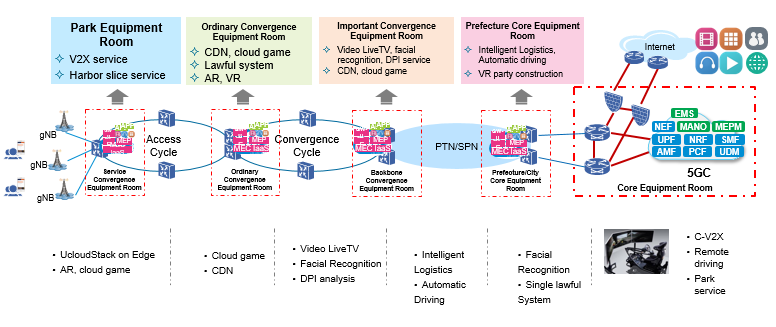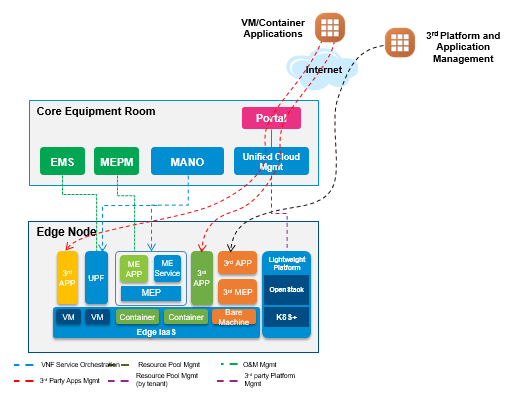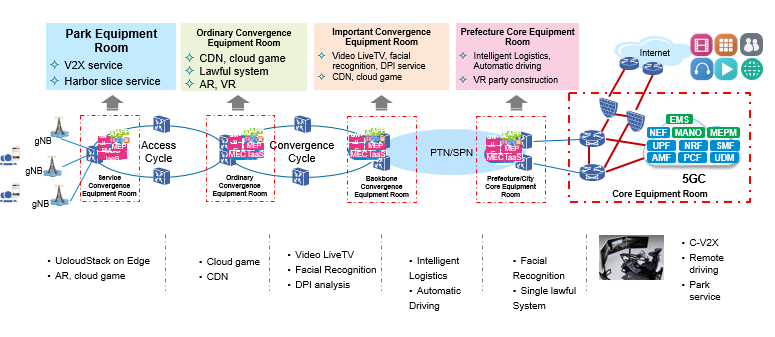With the rapid increase of digital and intelligent power requirements for terminals, the cost of terminals increases rapidly. On the one hand, terminals need to move their power to the cloud due to power consumption, cost, and space limitations. On the other hand, the cloud computing power cannot meet the service requirements with high real-time requirements, and makes services move to the edge. The application of the Multi-Access Edge Computing (MEC) technology has become a harshrate depression in the digital and intelligent era. Its services and harshrates are converged at the edge, which greatly improves network effectiveness and user experience.
Through large-scale deployment, Guangdong Mobile has fully verified the pre-commercial use of MEC with respect to commercial environment SA networking and surrounding resources, construction mode, cooperation mode with third party, and edge infrastructure management. It has accumulated valuable experience in 5G construction and future commercial use.
4-level architecture for network performance verification in two phases
Based on the 4-level MEC architecture (city/prefecture core equipment room + important convergence equipment room + ordinary convergence equipment room + service convergence equipment room), the MEC network environment is built by Guangdong Mobile in Guangzhou, including the core equipment rooms in the city or prefecture, important convergence equipment rooms in the districts or counties, ordinary convergence equipment rooms, and park service convergence equipment rooms. The MEC network construction experience is accumulated.

Figure 1 Guangdong Mobile MEC Overall Architecture Diagram
The project is validated in two phases, including MEC network deployment, platform function tests, and pilot service tests (including delay tests and QoS tests).
In the first phase, the pre-commercial validation of the commercial SA networking and surrounding resources, construction mode, cooperation mode with third party, and edge infrastructure management of the MEC is made, including MEC networking deployment, platform function tests, and pilot service tests (such as latency tests and QoS tests).
In the second phase, pilot services of MEC are arranged to verify MEC's 3-layer Iass/Pass/Sass solution, local bypass and interface capability exposing that support integration and deployment of third party and self-developed applications under the telecom cloud architecture. In addition, pilot verification and exploration is implemented by combining with network slicing for the end-to-end technical architecture, service quality assurance capability and business model.
ZTE MEC solution is oriented to 5G edge cloud
It can be seen that the MEC is combined with an operator network (the data plane function is a convergence point) to provide a new network architecture. The wireless access network provides IT services and cloud-end computing functions for telecom users, creating a carrier-class service environment with high performance, low latency, and high bandwidth, so that users can enjoy high-quality service experience in the 5G era.
ZTE's MEC solution is based on the ETSI reference architecture. Meanwhile, with respect to factors such as scattered locations of edge nodes, few resources, and many application types, heterogeneous computing capabilities are required while an integrated architecture and lightweight management are used to improve resource utilization. In addition, containers are introduced to support the deployment of vertical industry applications.


Figure 2 Logic Architecture of the Project Solution
- Diversified hardware resource pool
Considering the special requirements for services at the edge and equipment room conditions, in addition to general servers, this project also involves special hardware resources such as integrated servers, smart NICs, and GPUs, forming a diversified hardware resource pool.
- Heterogeneous lightweight platform
Due to limited edge resources, a lightweight platform is used to provide VMs, containers, and bare machines, meeting different edge service application deployment requirements.
- Management of unified resources
Unified cloudified management is deployed in the core equipment room to provide unified management of heterogeneous resources on edge nodes. MEPMs are deployed in a centralized mode to perform unified O&M management on the MEP of each edge node.
- Simplified deployment of applications
The unified cloud management system provides the portal page, simplifying the deployment of third party applications. The portal provides services in the multi-tenant mode. The third party remotely deploys APPs to the VM or container provided by the edge node. APPs (such as UPF and MEP) that comply with the NFV architecture are deployed and orchestrated through a unified MANO.
MEC is flexibly deployed in the service convergence equipment rooms, common convergence equipment rooms, important convergence equipment rooms, and municipal core equipment rooms to interconnect with the 5G core network of Guangzhou Mobile.

Figure 3 Guangdong Mobile MEC Service Solution Diagram
In addition, for toB, toBtoC and other service scenarios, third party partners are introduced, including CDN, cloud games, face recognition, video LiveTV, DPI service, V2X service, smart port service, smart forklift, and VR party construction.
MEC is promising to promote user experience
Through the implementation of this project, network requirements such as SPN/PTN, IP bearing and CMNET under different equipment room conditions have been fully verified, and the networking capability has been improved. At the same time, the applications of third party services have been fully verified in various scenarios and modes, such as improvement of high-performance data forwarding service performance, unified management of edge resource pools, applications of typical configuration models such as UPF/MEP, differentiated service guarantee capabilities of E2E slice, slice mall application signing and subscription, and multi-dimensional charging mode. These applications have accumulated valuable experience in guiding the large-scale commercial deployment of 5G MEC in the future.
MEC is both a resource computing platform and a wireless network capability platform. The in-depth integration of mobile access network and Internet services can not only improve user experience and save bandwidth resources, but also provide third party application integration, offering an imaginative space to service innovation at the mobile edge entrance.
By taking advantage of 5G development, operators can make full use of their network advantages (such as network capabilities, users, traffic, and data) and facility advantages (such as equipment rooms, transmission, and platforms), and focus on vertical industries and OTT service applications to actively build differentiated edge computing platforms and service capabilities. In this way, the integration of cloud, networks, edges, and terminals can be achieved, greatly reducing latency, improving user experience, and reducing transmission costs.
The network connection of the MEC platform is the key, the computing power is the effective guarantee, and the network capability and exposing is the driving force. The MEC platform provides high-quality network services, greatly improving user experience. This feature helps operators achieve the transition of the network from the access channel to the information service enabling platform.
ZTE supports AI with full-stack IT offering
5GC Green Engine Solution to Enable Green Internet of Everything in the Dual-Carbon Era
5GC Private Network 2.0 Empowerment and Efficiency Improvement Boosts High-Quality Development of the Industry
5G Empowers Intelligent Mining for High-quality Development of Shaanxi Coal Caojiatan Mining
ZTE and China Mobile embrace digitalization for biodiversity conservation in Panda Reserve
Three Aspects Contribute to ZTE’s Remarkable Breakthroughs in Advanced G4X Server
How 5G Private Networks Are Poised to Transform Enterprises Worldwide: All Scenario Private 5G Helps Operators to Realize Private 5G as a Service
ZTE’s commitment to servers generates robust growth of up to 60 times in past 8 years
ZTE eyes top 5 global server market share
Full-Scenario One-Stop 5G Private Network for Vertical Industries

